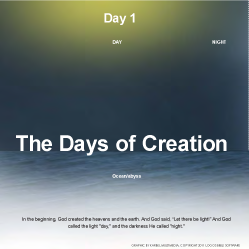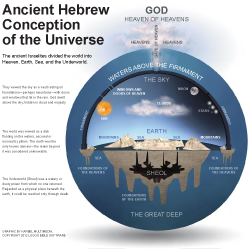1:1–2:3 The Bible’s opening narrative introduces the Bible’s main character—God. The creation account emphasizes God’s power as He brings all things into existence through divine decree. God’s creative activity occurs over six days in Gen 1:3–31. The account ends with the description of God’s rest on the seventh day in 2:1–3. |
1:1 In the beginning Genesis opens with the Hebrew
opens with the Hebrew phrase bere’shith, typically translated as “in the beginning.” There are two possible interpretations of this phrase: a specific, absolute beginning of all time; or a nonspecific, general beginning of God’s work of creation
phrase bere’shith, typically translated as “in the beginning.” There are two possible interpretations of this phrase: a specific, absolute beginning of all time; or a nonspecific, general beginning of God’s work of creation .
.
God The Hebrew word used here for “God,” elohim, is plural. While elohim may be used to describe multiple deities, ot authors usually use the term to refer to the singular God of Israel (more than 2,000 instances), such as here.
The Hebrew word for “create” (bara) is used in the ot to refer to divine activity only—Yahweh alone serves as its grammatical subject—implying the writer wanted to emphasize that people cannot create in the way that Yahweh creates and that no other god can claim to be the creator. The verb bara also conveys the idea of ordering or determining function, suggesting God’s creative activity consists of bringing proper order and function to the cosmos. |
created The Hebrew word used here is bara. Compare Isa 40:26; note on Gen 1:27.
the heavens and the earth This phrase refers to the entirety of creation. The ot often uses opposing word pairs to refer to a totality.
1:2 formless and empty The Hebrew terms used here, tohu and bohu, describe material substance lacking boundary, order, and definition.
darkness Throughout the Bible darkness represents evil or calamity. Here, darkness refers to the unformed and unfilled conditions of the material of v. 1.
the deep The Hebrew word used here, tehom, refers to the primordial or primeval sea—the cosmic waters of chaos.
the Spirit of God Since the Hebrew word used here, ruach, can mean “spirit” or “wind,” this phrase can be translated “Spirit of God” or “wind from God” (or even “mighty wind”). However, the pairing of ruach with God (elohim in Hebrew) usually refers to God’s Spirit.
1:3 And God said The ordering of creation begins with the spoken word.
Let there be light God creates light before the creation of the sun (Gen 1:14–18). This reflects an understanding of the world, common in the ancient Near East, that held that the sun does not serve as the source of light.
1:4 good God calls His handiwork good seven times in ch. 1 (vv. 4, 10, 12, 18, 21, 25, 31). The Hebrew word used here, tov, has a broad range of meaning but generally describes what is desirable, beautiful, or right. In essence, God affirms creation as right and in right relationship with Him immediately after He creates it. The material world is good as created by God.
caused there to be a separation between the light and between the darkness The division of time into day and night represents one of God’s first acts in the ordering of creation.
1:5 evening and there was morning, the first day The expression “evening and there was morning” specifies the length of a “day” (yom, in Hebrew). While the author may have meant a 24-hour day, less specific interpretations are possible. The Hebrew word yom can refer to a 24-hour cycle, the daylight hours, or an unspecified future “someday.” The meaning of the word, though, does not settle the debate over whether the passage references a literal six-day creation or symbolic days. In addition, the sun (which marks the change from evening to morning) is not created until the fourth day.
 Interpretations of the Days in Genesis Table
Interpretations of the Days in Genesis Table
1:6 a vaulted dome The Hebrew word used here, raqia', refers to a dome-like structure that was thought to separate the sky from the heavens (v. 8).
1:9–13 The third day of creation involves two more distinct acts of creation. Both are affirmed with the phrase, “And God saw that it was good.” The first three days of creation are characterized by three acts of separation: God separates light from darkness (v. 4), heaven from earth (vv. 7–8), and land from sea (vv. 9–10). |
1:9 waters under heaven The writer explicitly distinguishes the waters of the sea from the waters above the expanse because of the ancient Near Eastern view that the sky held back the waters above (compare note on v. 6).
dry ground The Hebrew term here, yabbashah, is used to distinguish the safety of dry ground from the chaotic danger of the sea. The term appears several times in the account of Moses and the Israelites safely crossing the Red Sea on dry ground (see Exod 14:16, 22, 29).
1:11–13 This passage refers to the creation of plant life, but it does not cover all botanical varieties. Similarly, the list of animals in Gen 1:20–25 does not represent all categories of animal life. Both lists are selective. Here, the seed-bearing plants and fruit trees likely represent only the plants designated for human consumption. |
1:11 Let the earth produce green God’s command for vegetation to grow is the first indirect command in the creation sequence. Previously, God has directly addressed each created thing. Now He commands the earth to produce plant life.
green The Hebrew word used here, deshe, can refer specifically to grass or generically to any plant life that sprouts from the earth.
plants that will bear seed The earth is to produce not only plants and fruit trees, but also plants and fruit trees that bear seeds.
according to its kind Refers to the broad distinctions between different types of plants and animals. All created things reproduce within the parameters set by God.
1:14–18 God creates the sun and moon on the fourth day. The sun, moon, and stars provide the daily and seasonal cycles required for agriculture that, combined with land and water, sustain life. |
1:14 lights The creation of the lights in the heavens on the fourth day parallels the creation of light in general on the first day. These lights produce another separation—day from night (compare note on vv. 9–13).
signs Celestial phenomena were often understood as divine signs in the ancient Near East (see note on Jer 8:2).
appointed times The Hebrew word used here, mo'adim, could refer to seasons—indicating the natural agricultural cycle—but mo'adim also frequently indicates religious festivals or sacred times.
1:16 two great lights This refers to the sun and the moon, but the writer deliberately avoids the words “sun” (shemesh in Hebrew) and “moon” (yareach in Hebrew) that correspond to the names of West Semitic deities: Shamash and Yarik.
1:20–25 Creation on the fifth day includes the creatures of the sky and sea. God creates land animals on the sixth day. These creative acts parallel the activity on the second day, when God separates sky and sea, and the third day, when land appears. |
1:20 living creatures Here, the Hebrew term nephesh refers to animal life.
While the Hebrew word nephesh (often translated as “soul”) can refer to animal life, it can also refer to human life or a person’s life force (their soul) along with emotions, intellect, personality, and will (see Gen 9:5; 27:4; Exod 23:9; 1 Sam 19:11). Nephesh can also refer to human corpses (Num 6:6, 11). |
1:21 sea creatures A translation of the Hebrew word tannin, which does not refer to any specific member of the aquatic kingdom.
1:22 Be fruitful and multiply God created life to be fertile. Here, the capacity for sexual reproduction is cast as a divine blessing.
1:26–31 The creation of man and woman is the climax of God’s creative activity. The statement that the creation of the animals was “good” in Gen 1:25 distinguishes God’s two acts of creation on the sixth day. First He creates land animals in general; then He creates humans. This passage contains several key words and concepts: God’s reference to Himself in the plural, the concept of the “image of God,” the separation of humanity into two genders—male and female—and the divine command for humanity to fill and rule the earth. |
1:26 Let us make The occurrence of “us” in this passage has been understood to refer to the plurality of the godhead: the Father, Son, and Holy Spirit. This understanding would have been unknown to the authors of the ot. Another possible explanation is the so-called “plural of majesty,” but this type of grammatical usage is more common for nouns and adjectives than verbs. A simpler explanation is that “us” reflects an announcement by the single God of Israel to a group in His presence—the heavenly host. Other ot passages support the idea of a heavenly host or divine council (Psa 29:1; see Psa 82:1 and note). This explanation also applies to Gen 11:7. The phrase “our image” then means that the members of the heavenly host also reflect the divine image.
 Plural Pronouns in Genesis 1:26
Plural Pronouns in Genesis 1:26
1:27 the likeness of God Being created in the image of God distinguishes people from all other earthly creation. God’s image is not described as being possessed in part or given gradually; rather, it is an immediate and inherent part of being human.
distinguishes people from all other earthly creation. God’s image is not described as being possessed in part or given gradually; rather, it is an immediate and inherent part of being human.
male and female There is no status distinction among bearers of the divine image; they are equal while having distinct capacities and roles in fulfilling the divine mandate to steward the earth.
he created them The Hebrew verb used here, bara, is the same word used in Gen 1:1. However, the plural declaration “let us make” in v. 26 uses a different verb. The verbs for “make” (asah) and “form” (yatsar) are also used elsewhere with bara to refer to God’s work as Creator in chs. 1–2. In ch. 2, yet another verb is used for the fashioning of Adam (yatsar). These verbs are synonyms. Compare note on v. 1.
1:28 Be fruitful and multiply As with the animal kingdom, humanity is created to be fertile. The capacity for sexual reproduction is cast as a divine blessing.
subdue it, and rule over These terms indicate active power or rule involving physical force or effort (Jer 34:16; Esth 7:8; Josh 18:1; Isa 14:2; Ezek 29:15).
1:29 food The seed-bearing plants and fruit trees created on the third day are here designated as food for the people God has just created. See note on vv. 1–13.
1:31 very good The totality of the ordered creation meets the expectations of its Creator. God is pleased with the results of His actions.

|
About Faithlife Study BibleFaithlife Study Bible (FSB) is your guide to the ancient world of the Old and New Testaments, with study notes and articles that draw from a wide range of academic research. FSB helps you learn how to think about interpretation methods and issues so that you can gain a deeper understanding of the text. |
| Copyright |
Copyright 2012 Logos Bible Software. |
| Support Info | fsb |
 Loading…
Loading…


 Bara
Bara 